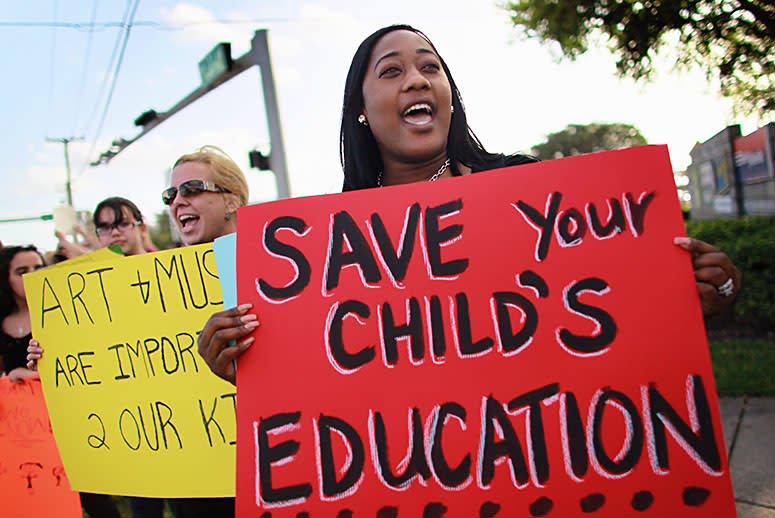Thousands of Teachers and Students Denounce Budget Cuts in Nationwide Protests

Raising signs that read “Support Our Schools” and “Actions Speak Louder Than Words,” teachers, students, and community members held walk-ins across the country Wednesday morning to demand increased support for public education. The nationwide rallies were organized by the Alliance to Reclaim Our Schools, a nonprofit advocacy group comprising teachers’ unions and other groups, and interrupted classes in more than 900 schools in 30 cities across the U.S.
Demands varied by city and school district, but most shared a common grievance: lack of funding. Students and teachers pleaded for more public libraries, better special education programs, and less standardized testing, among other things. One Chicago school community simply asked for more teachers, while another, in Los Angeles, protested expansion of publicly funded, privately run charter schools.
The Center on Budget and Policy Priorities, a left-leaning nonpartisan research organization, reported last month that most states have failed to restore prerecession funding levels.
Even school administrators were calling for higher priority to be placed on creative subjects such as music, dance, theater, and art classes.
It’s no secret that arts programs in public schools are dwindling, with more budget cuts every year in some states. Last November, the Los Angeles Times used L.A. Unified School District data to rank arts programs in schools. Only 35 out of 700 schools received an “A” grade for their arts programming.
But creativity is a valuable part of the learning process, and many teachers argue that overreliance on high-stakes testing diminishes programming that aids’ students’ ability to think critically.
RELATED: After Draconian Cuts to Arts Education, Is a Creativity Renaissance Coming to America’s Classrooms?
One study shows that this deprioritization of arts programs is a trend that starts as early as kindergarten. Researchers at the University of Virginia compared classrooms and teachers in 1998 and 2010, and found dramatic differences in curriculum, classroom structure, and expectations of students. The number of classrooms that had weekly art instruction decreased by 8 percent, and by 15 percent for dance instruction. Half of kindergarten teachers surveyed reported never doing theater activities with students in 2010, as opposed to 18 percent in 1998. Today, students are expected to know more coming into kindergarten, and teachers place more emphasis on science, technology, engineering, and math education and less on creative or nonacademic programming.
Many of the teachers and students marching at schools around the country are protesting that very trend. Demonstrators in various cities listed what they thought public school students were entitled to. “Art and chorus,” wrote one Miami student. “Art classes,” wrote a young girl in Denver. A teacher in Pittsburg simply added, “the resources we need to be successful.”
